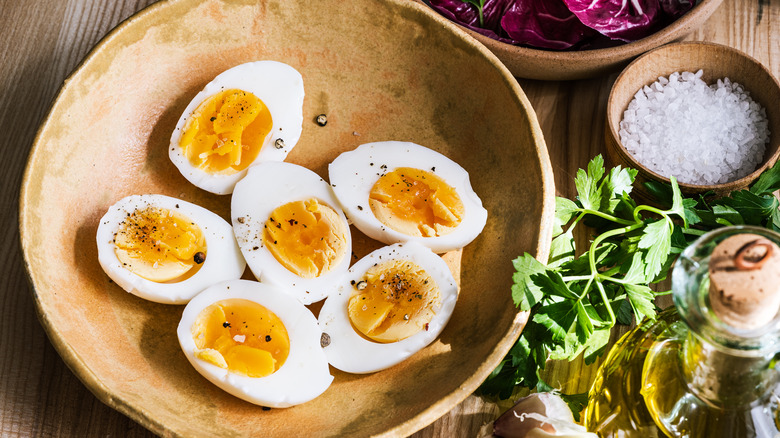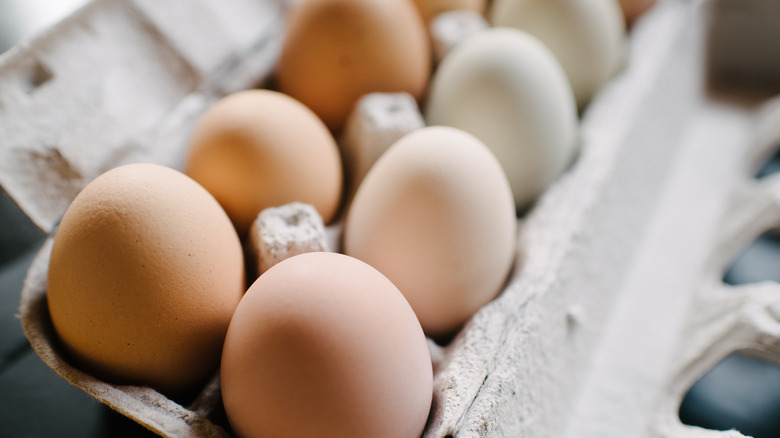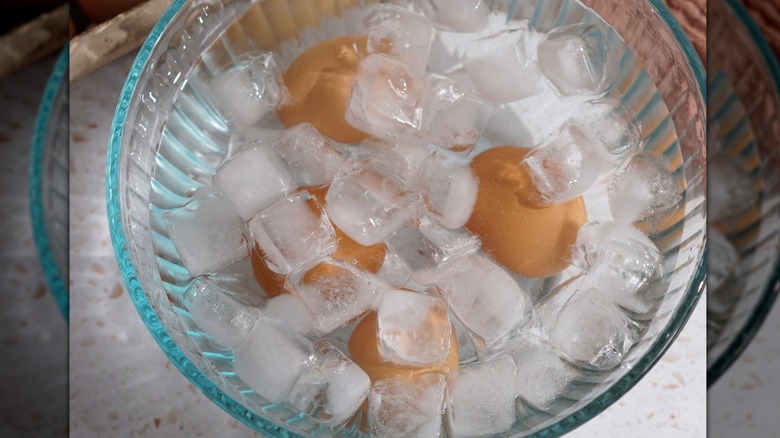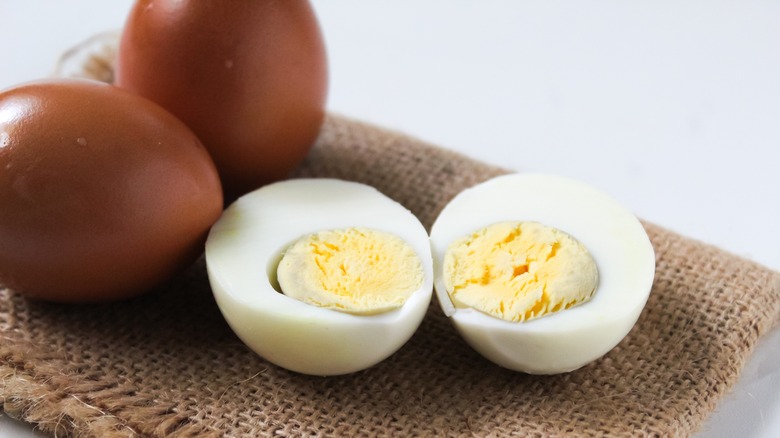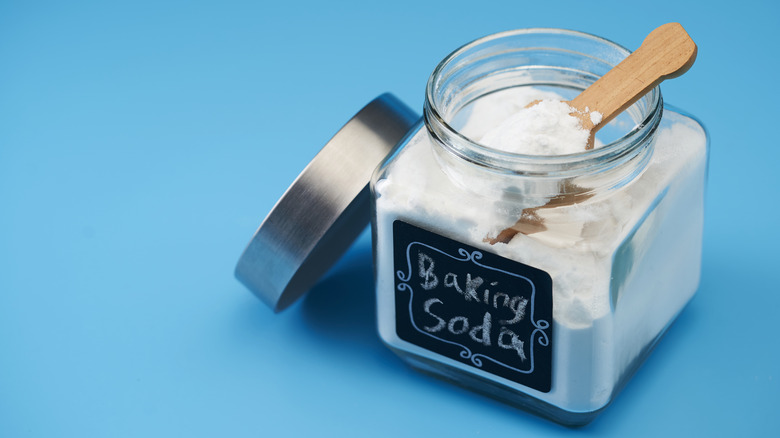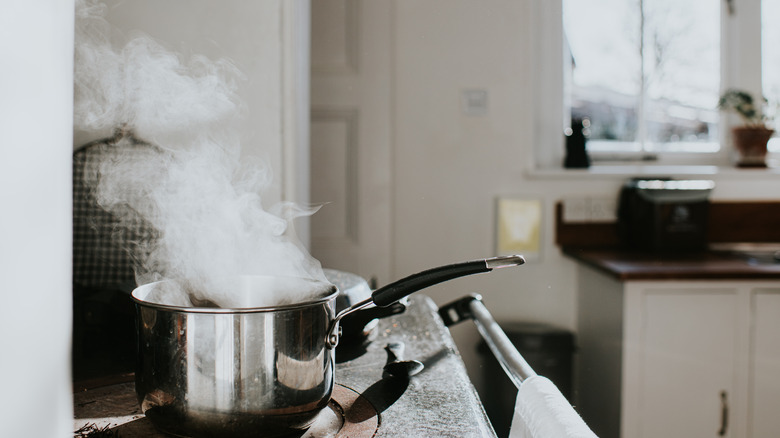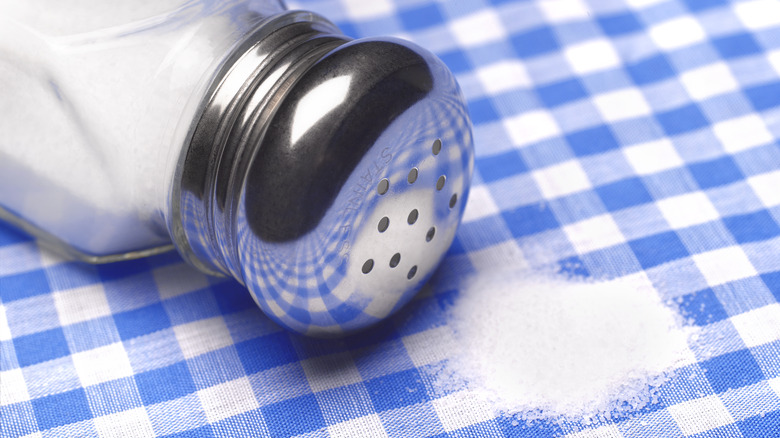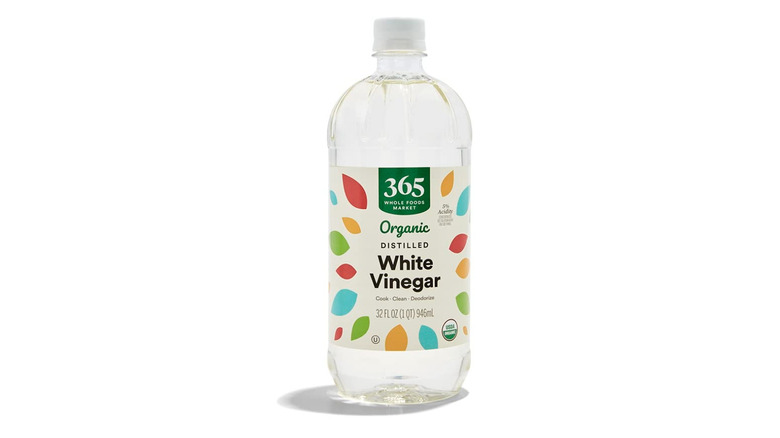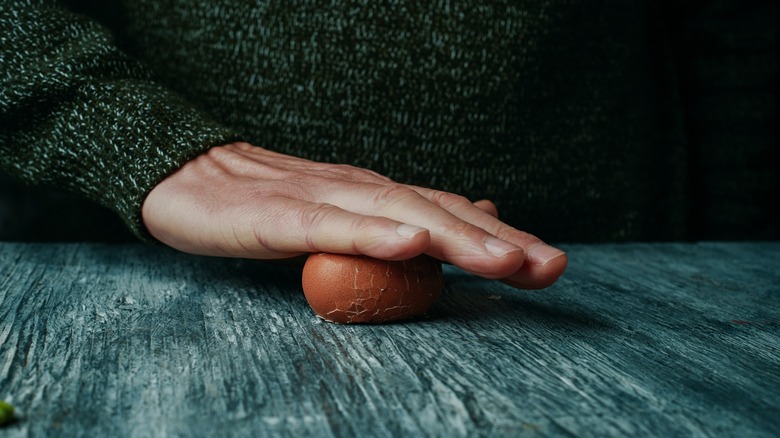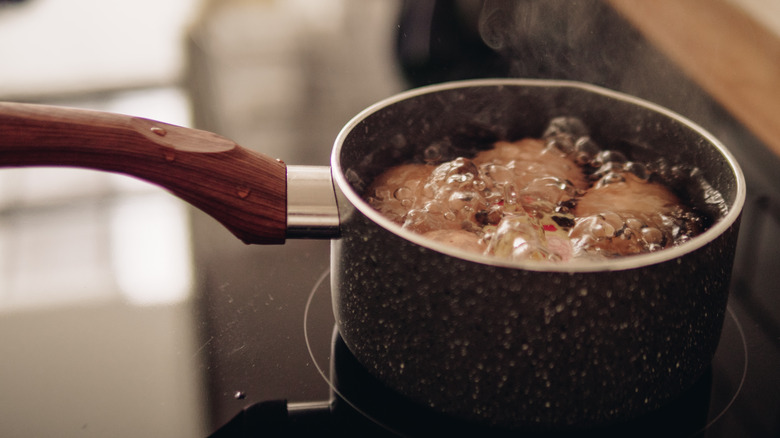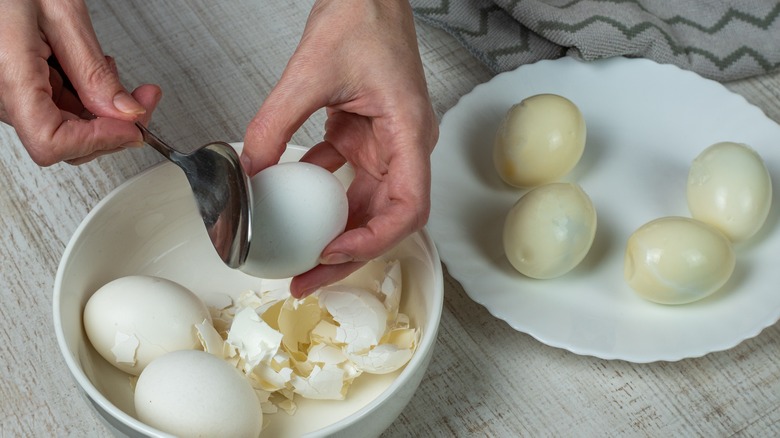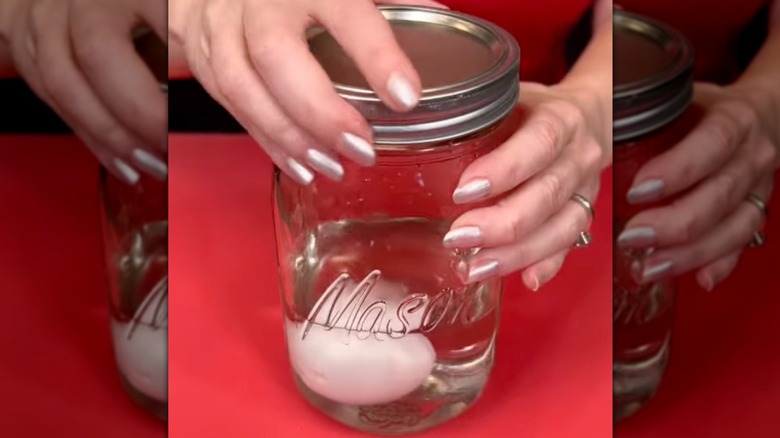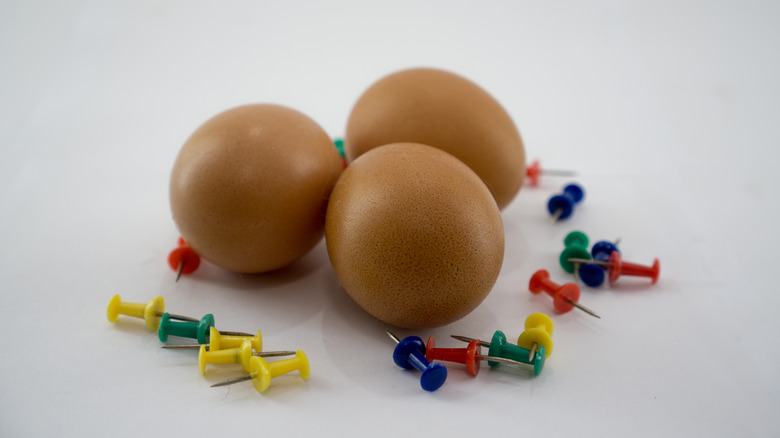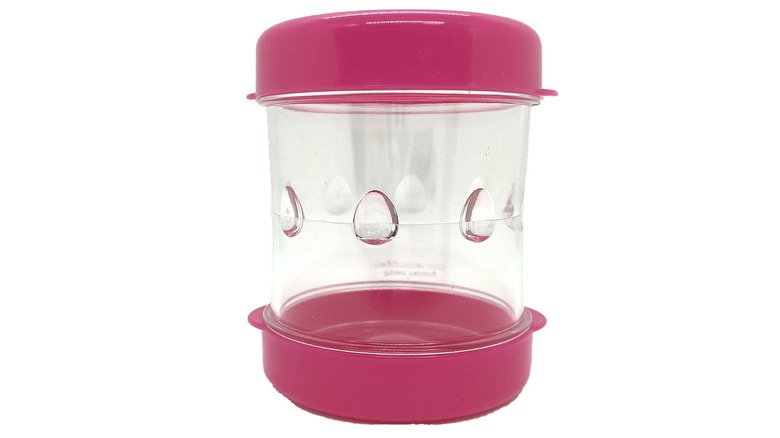13 Tips For Peeling Hard-Boiled Eggs
We may receive a commission on purchases made from links.
There are several steps that go into cooking up a batch of perfectly boiled eggs, the most important being timing. For hard-boiled eggs, you will want to boil them for between 10 and 12 minutes, depending on how firm you like the yolk. Boiling eggs for longer than this may result in overly dry and green-colored yolks and rubbery whites. Once you have nailed the timing, the next step is peeling the eggs without losing any bits of albumen to the shell. This can be particularly important if you are making a dish where aesthetics are key, such as pickled eggs.
We are all familiar with the challenge. No matter how meticulous we are about the cooking process, hard-boiled eggs can be notoriously tricky to peel. Luckily, there are a few tried-and-true methods that can make de-shelling hard-boiled eggs faster and easier. Some of them focus on how you cook the eggs, while others hone in on the intricacies of the peeling technique itself. Curious about some of the best ways to achieve perfectly smooth hard-boiled eggs? Take a look at our list of quick tips bound to make your next batch of peeled eggs flawless.
Age the eggs
Eggs do not spoil quickly, provided that they are appropriately refrigerated. If you are not sure how long you can safely keep your eggs, take a look at the two dates displayed on the carton. The first is the packaging date shown as a three digit number that marks the day of the year from 001 for January 1 to 365 for December 31. The second is the EXP (expiration) or sell-by date. That said, eggs are usually safe to eat beyond this date, and can be stored in the refrigerator for between three and five weeks from the date of purchase (but you should definitely test them first to make sure they have not gone bad, like by using the the sink or float method in water).
Interestingly, older eggs are easier to peel. This is because eggs gradually lose moisture through tiny pores in their shells. As they age and lose more and more moisture, eggs shrink in size, pulling the membrane away from the shell. This also increases the size of the air pocket at the wider end of the egg, making it easier to peel. Finally, fresh eggs have a low pH level, which causes the egg whites to bond to the membrane of the inner shell. As eggs age, their pH level rises, making the whites less attached to the membrane. To make peeling easier, it is best to keep ultra-fresh eggs in the refrigerator for a week or two before boiling them.
Place the eggs in an ice bath immediately after boiling
When it comes to de-shelling hard-boiled eggs, you can't go wrong with submerging them in an ice bath after boiling. The shock associated with the rapid temperature change is said to pull the egg whites away from the shells, making the peeling process easier. While the eggs can sit in the ice bath for much longer, it is best to leave them there for at least a few minutes. Placing newly boiled eggs in an ice bath also has another advantage — it stops the cooking process. This, in turn, can prevent the eggs from overcooking and becoming rubbery.
The cold shock immersion method can be combined with most other egg-peeling techniques to make them more effective. For best results, combine water and ice cubes in a bowl while the eggs are boiling. Be sure to use plenty of ice since the hot eggs will melt it relatively fast. Keep the ice bath ready near the stove and carefully transfer the eggs from the saucepan into the ice bath using tongs.
If you are worried that the ice bath will make the eggs cold and unappetizing, do not be, as one Reddit user explains. "If you want to eat them while they are warm, take them out of the ice water when they are still warm. You still want to use the ice water, though, so they don't continue to cook after you take them out of boiling water," they say.
Peel the eggs under running water
Probably one of the most common methods for peeling eggs is to loosen their shells under running water. Simply hold a hard-boiled egg under a stream of cool water and gently try to separate the shell from the membrane.
Not only does the water provide additional lubrication that can simplify the shell removal process, but the water pressure may also help lift the shell away from the egg. Peeling eggs under running water also makes it easier to remove any stubborn shell specks that might be left clinging to the membrane.
Boil the eggs with baking soda
Adding a little baking soda to the water when cooking eggs can change their pH level. While this may not seem like a big deal, it can be a game changer in the egg peeling department. Freshly laid eggs have a low pH level, which gradually increases as they age. This elevated pH level, in turn, makes it easier to separate the eggshells from the albumens. This is precisely why eggs that are boiled after being refrigerated for a couple of weeks are easier to peel.
This method is as simple as adding a teaspoon of baking soda to a pot of water before boiling the eggs. While baking soda does have a very distinct taste, this will not affect the insides of the eggs.
Steam the eggs to help separate the membranes from the whites
The traditional method of making hard-boiled eggs involves cooking them in a pot of boiling water. However, this is not the only way to achieve perfectly cooked eggs for your potato and egg sandwich or any other dish you have in mind. Another method of preparing hard-boiled eggs involves steaming. Not only does this produce the same outcome as boiling, but it also makes the eggs easier to peel. This is because some of the ultra-hot steam seeps through the eggshell, making shell removal more manageable.
To steam your eggs, place them in a steamer basket. If you do not have one, a metal colander will also do the trick. Fill a pot with an inch or two of water, so it reaches the steamer basket or the colander. Bring the water to a boil and place the steamer basket or colander with the eggs inside the pot. Cover the pot with a lid and steam the eggs on medium-high for around 12 minutes. If you do not happen to own a steamer basket or a colander, you can try steaming the eggs directly in the pot. Simply fill a saucepan with half an inch of boiling water and place the eggs directly in the pot before covering it with a lid. Whichever kitchen utensil you choose to use, for best results, be sure to arrange the eggs in a single layer.
Boil the eggs in salty water
If you need easy-to-peel eggs for your egg and anchovy appetizers, you can try mixing the cooking water with a little salt before boiling them. While this has not been scientifically proven, some home chefs are adamant that this cooking technique helps loosen the eggshells, making them easier to peel. The theory behind this is that the salt molecules dissolve in boiling water, becoming tiny enough to make their way under the eggshell and help create a slight separation between the shell and the egg white.
While it is unclear if this approach truly makes peeling easier, boiling eggs in salty water can have other advantages. Salt can help to seal any minor cracks that may appear in the eggs as they tumble in the pot. Adding a little salt to water also causes it to boil more quickly, thus speeding up the cooking process. Finally, salt can also help the proteins in the yolks and whites harden, which may prevent the egg whites from leaking during the boiling process.
Boil the eggs with white vinegar
Mixing acidic substances like white vinegar with boiling water weakens eggshells, which may make them easier to peel. White vinegar is ideal for the job because it contains plain acetic acid. Other cooking products, like apple cider vinegar or rice vinegar, are less likely to work as well, since they include additional ingredients, which make them less concentrated.
Acidic cooking products do their magic by breaking down some of the calcium carbonate in the egg's casing. If you do not believe us, try submerging an entire egg in a cup filled with vinegar. Given enough time, the vinegar will completely dissolve the eggshell, leaving behind just the membrane and the naked egg.
Roll the eggs on a countertop
The tap, roll, and peel method is one of the easiest ways of separating the egg from the shell, and all you need is a countertop to make it happen — no special ingredients or utensils are required. Firstly, make sure that the table surface is clean — the last thing you need is an egg that has been contaminated with germs. To keep things more sanitary and simplify cleanup, you can cover the countertop with a paper towel or work on a cutting board.
To peel the egg, tap it gently on the kitchen counter. It is best to start at the larger end of the egg, since this is where the air bubble usually sits. Once the eggshell is cracked, roll the egg back and forth on a countertop using the palm of your hand. Be careful not to push the egg too hard while rolling as this could crush it or damage the egg white. Once the shell has been loosened, start peeling the egg from the wider end where the air pocket is located. If you are still struggling to get the little pieces of shell off the egg, finish peeling it under running water.
Drop refrigerated eggs into boiling water
Just like plunging boiled eggs in ice water shocks them, so does placing refrigerated eggs in boiling water. Instead of taking your eggs out of the refrigerator, placing them in lukewarm water, and bringing them to a boil, this method involves putting cold eggs directly into boiling water. For optimal results, use a slotted spoon to gently lower the eggs into the water. This is because the sudden impact of dropping them into the saucepan could damage the shells. Once the eggs are in the water, reduce the heat to a simmer.
While it is not exactly clear why shocking eggs in boiling water makes them easier to peel, many swear by this method. Online, people note that slow-cooking eggs by gradually bringing the water to a boil causes the egg membranes to fuse to the egg whites, making the eggs trickier to peel. Conversely, submerging refrigerator-temperature eggs in boiling water has the opposite effect, resulting in peel-able eggs.
Use a spoon to remove the eggshell
Both eggs and kitchen spoons feature a similar curved shape, making the spoon a very helpful tool for de-shelling eggs. The goal is to slide the spoon between the egg and the thin membrane that surrounds the egg white so that it can be removed nicely along with the eggshell. If you have ever used a spoon to scoop out avocados or kiwi fruit, you should be familiar with the concept
To separate the egg from the shell, gently crack the larger, air bubble end of the egg. After peeling as much of the casing as possible, carefully slide the tip of the spoon under the thin membrane to break the bond between the egg white and the shell. Next, rotate the egg until you maneuver your way around the entire shell. While this method may take a little practice, you should eventually be able to lift off large sections of the eggshell, leaving behind perfectly smooth eggs worthy of deviled eggs or any other elegant appetizers.
Shake the eggs in a container to loosen the shells
The main advantage of this eggshell removal method is that you can de-shell multiple eggs at once, saving valuable kitchen prep time. As such, this technique is particularly useful when preparing a large batch of eggs for dishes like salads or sandwiches. All you need to get started is a suitable container and a little muscle power.
At its simplest, you can de-shell the eggs in the same pot where they were boiled. After draining the water, shake the pot back and forth to let the eggs crack against its walls and each other. The trick here is to use enough force for the eggs to crack but not so much force that you damage them.
Alternatively, you can perform the same process in a glass container. If you are using a Mason jar, it is best to fill it with a little water to cushion the eggs while you shake it to loosen the shells. Once the shells start to break, the water will remove any bits still clinging to the egg whites. If you do not have a Mason jar on hand, you can also shake the eggs in a regular drinking glass. Simply pop your egg into the glass and fill it with a little water before sealing it with your hand and sharing it vigorously.
Use the thumbtack trick
If you think piercing an egg is going to cause it to crack, do not worry. We are only talking about an ultra-small puncture hole that is actually going to make it easier to peel the egg after it has been hard-boiled. The egg will remain intact, provided that you puncture it at the wider end without using too much force or creating multiple openings. Be sure to sanitize the thumbtack before use and always remove it before submerging the egg in water.
So how does puncturing a fresh egg make it easier to peel later on, you may ask? The answer has a lot to do with the egg's structure. According to some, the tiny hole created in the shell lets scalding water seep between the egg's membrane and shell, making de-shelling easier once the egg has boiled. Another possible advantage of puncturing the eggshell is that it may release internal pressure from inside the egg, preventing it from cracking as it boils.
Use a gadget to peel the eggs
While egg cookers can take the guesswork out of making eggs, there are also other gadgets designed specifically to take the hassle out of peeling. While some of these devices are gimmicky, others can be surprisingly effective. On the downside, a while back, The Takeout reviewed the Eggstractor, with less than impressive results, noting that the device often damaged rather than peeled eggs.
While we can't recommend the Eggstractor, there are other egg peelers on the market that look more promising. One of these is the Negg Boiled Egg Peeler, a plastic container engineered to make peeling eggs quick and effortless. To remove the shell, fill the gadget with a little water, place the egg inside, close the lid, and shake gently. Alternatively, you can invest in the Fox Run Hard-Boiled Egg Piercer, which works on the same principle as a thumbtack. This tool pierces a small hole in the shell before boiling, which is said to make peeling easier later on. It is a pretty egg-cellent tool we definitely plan on using in the future to peel our hard-boiled eggs.
